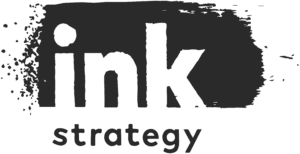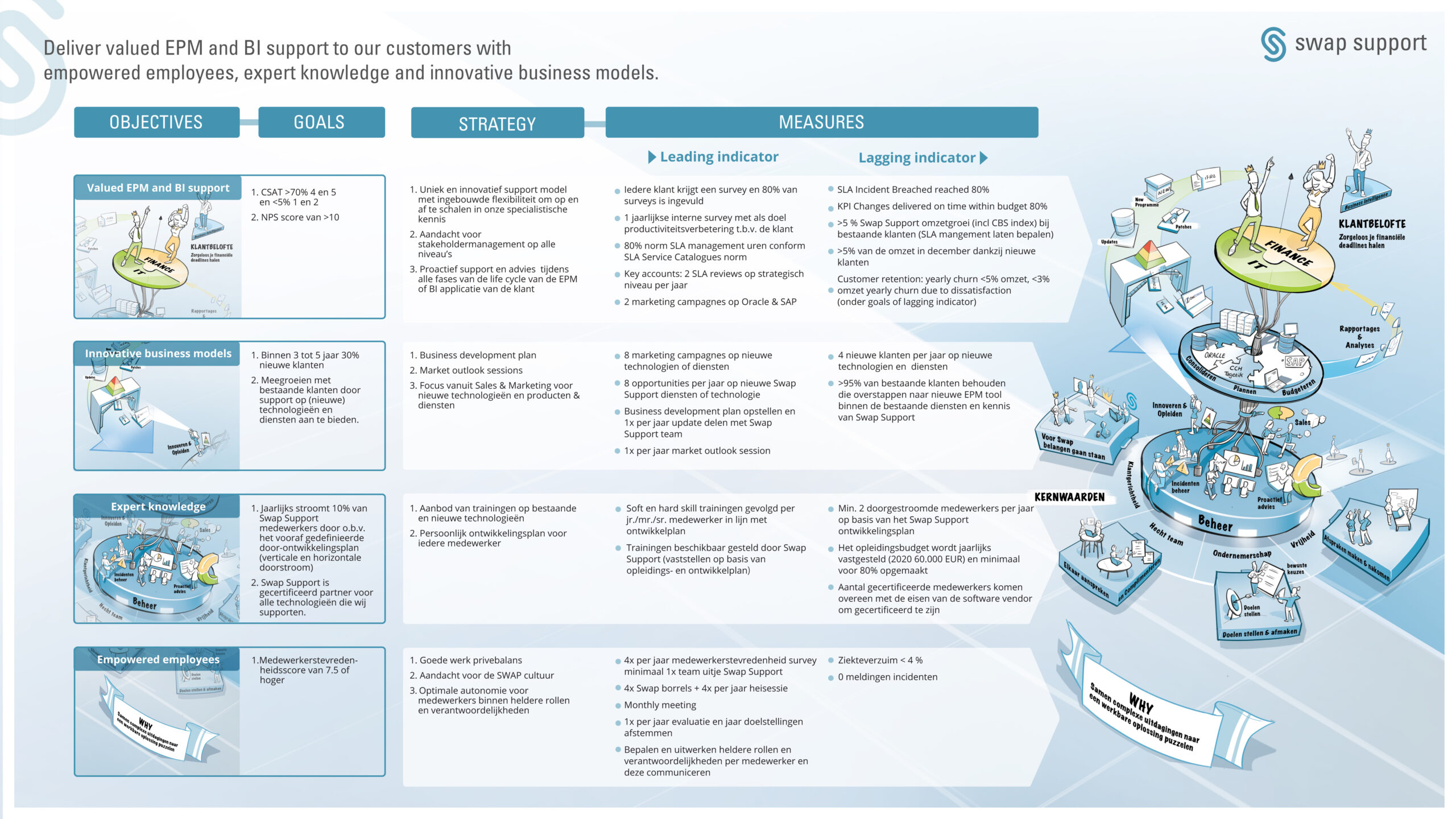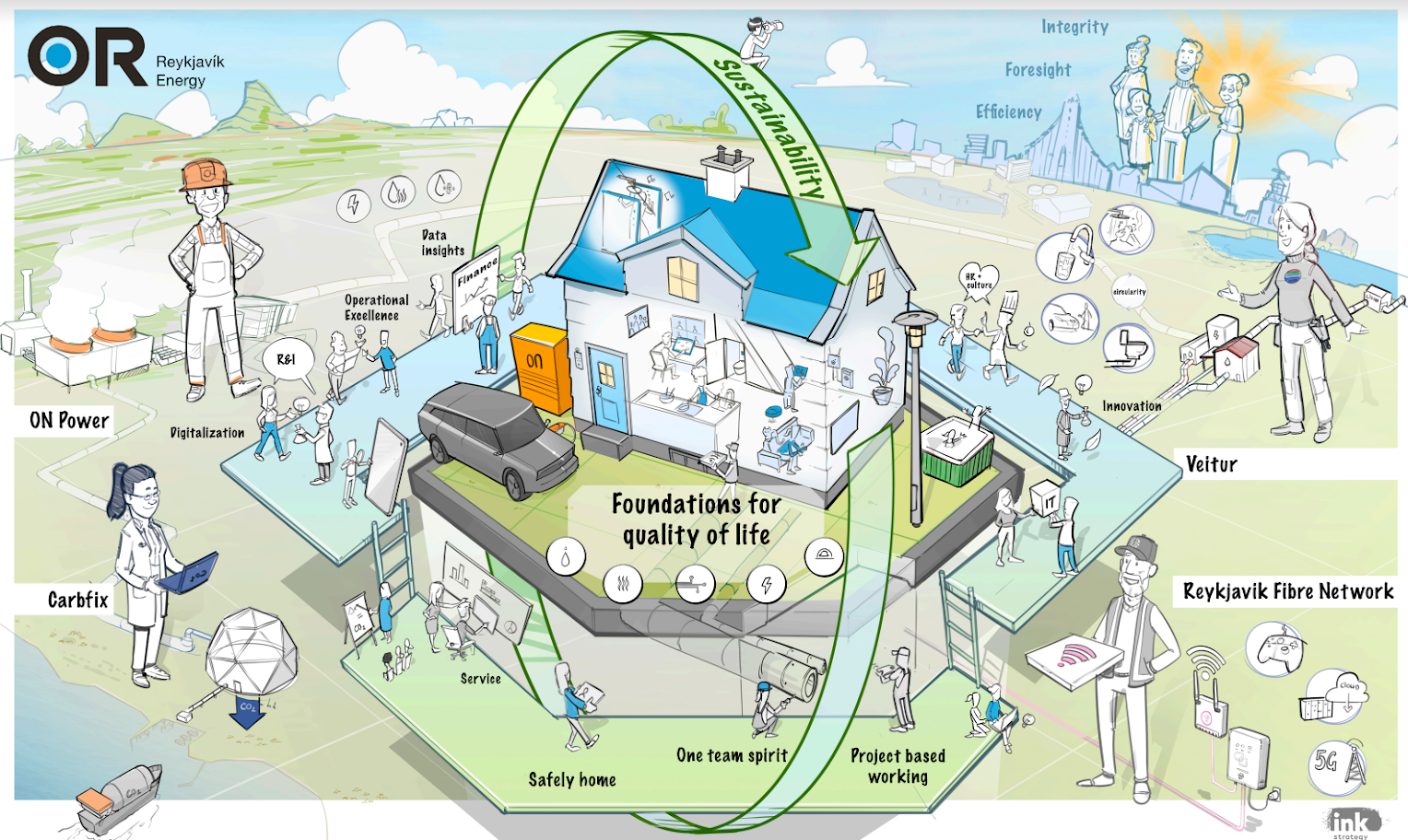The OGSM model is a strategic planning model that connects the dots in your strategic plan...
Storytelling is an art as old as humanity itself. It began with cave drawings, where our ancestors communicated their experiences, traditions, and beliefs. Over time, storytelling has evolved into a powerful tool for communication, connection, and persuasion. In this blog post, we will delve into the world of storytelling, exploring its various forms, its impact, and the principles that make it effective. Whether you’re an individual looking to share personal stories or a corporation seeking to engage and inspire your audience, this comprehensive guide will provide you with the insights you need.

What is storytelling?
At its core, storytelling is the act of conveying a narrative to an audience. It goes beyond mere entertainment; it is a fundamental human need and is at the core of things like coffee corner conversations, books, entertainment and even forms the foundation for governments or nation states. Stories help us make sense of the world, connect with others, and impart wisdom. From ancient myths to modern novels, storytelling has always played a pivotal role in shaping cultures and societies. Cave drawings were the earliest forms of storytelling, illustrating human experiences, hunting techniques, and spiritual beliefs. Today, storytelling takes various forms and is ever evolving and is becoming an important part of they way we do business. Ben Horowitz once said “your story is your strategy” highlighting how important storytelling is to investors.
“Companies that don't have a clearly articulated story don't have a clear and well thought-out strategy”

Personal storytelling vs. corporate storytelling
In the realm of storytelling, there are two distinct approaches: personal storytelling and corporate storytelling. Personal storytelling allows individuals to share their unique experiences contrary to corporate storytelling where consistency over a large group of people key to maintain a unified direction. However, finding the right balance between personal and corporate storytelling is crucial. By infusing vulnerability into corporate storytelling, organizations can connect with their audience on a deeper level. At Ink Strategy we combine the learnings from personal storytelling with the core objectives of corporate storytelling during out storytelling workshops.
Personal Storytelling
Allows individuals to share their unique experiences, emotions, and perspectives
Each story is personal, reflecting the storyteller's journey and authenticity
Can take on nearly any form or story archetype.
Corporate storytelling
Aims to align a company's values, mission, and goals into a cohesive narrative
Consistency is key, as every employee must tell the same story to maintain a unified brand image.
Often conforms to a framework of key points needed to be shared.
The power of storytelling
Storytelling possesses a transformative power that goes beyond words. It creates a holistic structure that engages the audience emotionally, intellectually, and spiritually. By weaving together various elements such as characters, plot, and themes, storytelling establishes connections within the content, making it more relatable and memorable. Furthermore, storytelling introduces purpose and direction, giving the audience a sense of meaning and inspiration. By touching people with shared experiences, storytelling fosters empathy and encourages positive change.
Core principles in storytelling
To create impactful stories, several core principles should be kept in mind. First and foremost, a story should be memorable. Utilize compelling characters, vivid imagery, and engaging dialogue to leave a lasting impression on your audience. Secondly, a story should be unique. Find your distinct voice and perspective, setting yourself apart from others. Lastly, a story should create an impact. Whether it’s evoking emotions, provoking thought, or inspiring action, your story should have a tangible effect on your audience.
The science behind storytelling
Storytelling is deeply ingrained in our biology and psychology. In the image below you see two brains. The image of the brain on the left is listening to plain information. Only two areas really light up, one processing language and one connecting the dots. the brain on the right illustrates someone listening tot a story. Far more many parts of the brain light up processing emotions, memory, sensory experiences along with the more logical parts of language comprehension.

Understanding these differences can help tailor your storytelling approach to resonate with a broader audience and using storytelling give you a far greater likelihood of impacting the listener to change their behaviour.
Hormones and storytelling
Storytelling can have an impact on our emotional state. For example the brain can release Oxytocin, the cuddle hormone when a person has the feeling of affection and empathy. You can draw out this hormone by adding a personal touch to your storytelling approach. For example you can put yourself at the center of your story, and share vulnerability. Dopamine, known as the “reward hormone,” is associated with memory and motivation. It’s the little red signal on your phone that tells you you have a message. Visual triggers and imagery give your a brain a Dopamine kick. Serotonin, the “feel-good hormone,” contributes to our sense of well-being and happiness through feeling of trust and positivity. We can engineer our stories around recognition of the audiences feeling to trigger these hormones to be produces. By leveraging the science behind storytelling, you can create narratives that captivate and engage your audience and have a far greater emotional impact.

Different types of learners
Different individuals learn and process information in different ways. Some are visual learners, while others prefer auditory or kinesthetic methods.

In any group, roughly 40 percent will be predominantly visual learners who learn best from videos, diagrams, or illustrations. Another 40 percent will be auditory, learning best through lectures and discussions. The remaining 20 percent are kinesthetic learners, who learn best by doing, experiencing, or feeling. Storytelling has aspects that work for all three types. Visual learners appreciate the mental pictures storytelling evokes. Auditory learners focus on the words and the storyteller’s voice. Kinesthetic learners remember the emotional connections and feelings from the story. A good story connects to all different learners.
Simon Sinek’s “Why, How, What” framework

Simon Sinek’s “Why, How, What” framework is a powerful mental model in storytelling. By starting with the “Why,” you tap into the emotional core of your audience, appealing to their beliefs and values. The “How” illustrates the process or strategy behind your story, providing a logical framework. Finally, the “What” represents the tangible result or product that supports your story. This framework aligns with different parts of the brain, engaging first and most importantly our reptilian brain responsible for our deep rooted identity, beliefs and values. Our limbic system, responsible for emotions, and experinece lines up nicely with ‘how’ in Simon’s model and the noecortex, responsible for rational thinking is involved in rational processing or figuring out the more superficial evidence presented in Simon’s ‘what.’ Understanding this neurological connection can help you craft more persuasive and impactful stories with different abstraction levels in storytelling. Your goal is the engage the whole brain not just the
A practical guide to crafting your own story
Crafting a compelling story involves a step-by-step process that ensures coherence and impact. Start by defining your objective in telling your story. What do you want to tell your story about and what is the objective of telling the story. The next and essential step is to empathise with your target audience. What do they already know now and what do you want them to know, feel and do after hearing your story. Research their needs, desires, and pain points in more depth using an empathy map to create a story that speaks more directly to them if you want to go further. Use this understanding of your audience to help craft strong characters that your audience can relate to and invest in emotionally. Now it’s time to choose a storyline an create a well-structured plot that takes your audience on a journey, building tension and resolving conflicts. There are multiple archetypes of storylines that you can use to design your core message around. Write out the key messages you want to get across per chapter and then start practicing. You can download this storytelling canvas below and use it as a guide to design your own story.

A few extra ingredients
Finally, infuse your story with authenticity and vulnerability, allowing your audience to connect with your story on a deeper level. Define how long you want your story to be, in most cases shorter keep it short and simple. You may want to consider what type of tone of voice you need are you in a formal setting or is the goal to be humours and lighthearted. Add a personal touch to your story but remember that you are conveying a clear core message. That is a lot of balls to juggle at the same time so following a practical guide can help to create a narratives that captivate and engage your audience and remember practice makes perfect.

Tips on delivering your story on stage
When delivering your story on stage, there are several key tips to keep in mind. Firstly, make contact with yourself and breathe, grounding yourself in the present moment. Maintain eye contact with the audience, establishing a connection. Secondly, focus on conveying one central message that will stick with your audience. Use sensory language and vivid descriptions to make your story more engaging and immersive. Importantly, be honest and genuine, as authenticity is essential in establishing trust. Finally, supplement your storytelling with visual aids such as pictures or drawings, enhancing the audience’s understanding and retention.
Prepare for your presentation by writing down some of the difficult questions you may be asked and try to formulate answers.
- What questions do you expect?
- What resistance do you expect
Dealing with resistance and basic human needs
When telling a story, it is essential to recognize that it’s not just a one-way communication. Stories are invitations to engage in a dialogue with your audience. As such, it’s crucial to anticipate and embrace the possibility of encountering resistance from some listeners. Resistance can manifest in various forms, such as skepticism, disagreement, or even indifference. However, rather than seeing resistance as a negative aspect, view it as an opportunity for growth and deeper understanding of our basic human needs. Here are three tips on how to deal with resistance after storytelling.
Embrace dialogue to build bridges
Shift your mindset from viewing storytelling as a monologue to embracing it as a dialogue. Encourage questions, comments, and feedback from your audience at the end of your story. When listeners express resistance, treat it as a chance to engage in a thoughtful conversation. Be open to differing perspectives and avoid becoming defensive. Remember that storytelling can be a powerful tool for building bridges and fostering understanding, even amidst disagreement.
Apply multi-level listening
Multi-level listening involves paying attention not only to the words spoken but also to the emotions, intentions, and underlying messages conveyed by your audience. When facing resistance, listen actively and empathetically to what your listeners are saying, as well as what they may be feeling but not expressing outright. By understanding their underlying concerns, fears, or doubts, you can respond in a more meaningful and respectful manner. Try to identify a basic human need they are concerned about. The basic human needs are certainty, uncertainty and variety, significance, connection and love, growth and contribution.
Address concerns with empathy
When addressing resistance, respond with empathy and respect. Acknowledge the legitimacy of your audience’s concerns and validate their feelings. Show that you genuinely value their input and that their perspectives are essential to the conversation. Avoid dismissing or belittling their doubts, as this may create further resistance. Demonstrate empathy by ask clarifying questions to gain deeper insights into their perspectives. This approach demonstrates your genuine interest in understanding their context and concerns.
Reframe, adapt and evolve
Sometimes, resistance arises due to misunderstandings or differing interpretations. Take the opportunity to reframe your story or message, finding common ground with your audience. Highlight shared values or goals that can bridge the gap between opposing viewpoints. By doing so, you can create a more inclusive and collaborative atmosphere.Accept that resistance can be a catalyst for growth and improvement. Use the feedback you receive from your audience to adapt and evolve your storytelling approach. Reflect on how you can better address potential points of resistance in future presentations.
Storytelling for impact
Storytelling is an ancient art that continues to captivate and inspire. Whether you’re sharing personal experiences or aiming to engage a corporate audience, the power of storytelling cannot be underestimated. By understanding the core principles, leveraging scientific insights, and employing effective storytelling techniques, you can craft narratives that resonate with your audience on a profound level. Remember, the true magic of storytelling lies in its ability to connect, inspire, and transform even when presented with resistance.
If you need assistance in running a storytelling workshop or refining your storytelling skills, reach out to Ink Strategy—our team is dedicated to helping individuals and businesses harness the power of storytelling.
Recent posts
A bigger picture helps team collaborate, clarify ideas and empower the entire organisation...
It seems like remote meetings are here to stay. Read up on how to get the most out of your...




